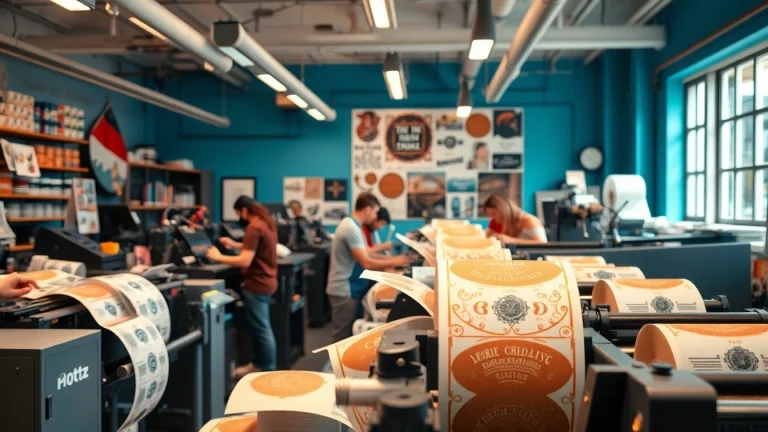
Top Strategies for Effective Labels and Printing to Elevate Your Brand
Understanding Labels and Printing Basics
In the world of marketing and product presentation, labels and printing play a vital role in shaping consumer perceptions. Labels serve not only as identifiers for products but also as powerful tools for branding, conveying essential information, and enhancing shelf appeal. This article explores the fundamentals of labels and printing, diving into types, materials, designs, and advanced techniques while addressing common challenges and measuring success.
What Are Labels and Their Importance in Branding?
Labels are more than just adhesive paper stuck to a product; they are an integral part of a brand’s identity. A well-designed label communicates the essence of a brand, including its values, mission, and product benefits. Labels can influence purchasing decisions significantly; studies have shown that consumers often judge a product by its packaging before considering other factors.
Labels also provide necessary information such as ingredients, usage instructions, and compliance with legal regulations. In some cases, they might include QR codes that lead customers to more in-depth product information or promotions. Hence, effective labeling can enhance customer trust and contribute to brand loyalty.
Different Types of Printing Techniques
There are several printing techniques available in the industry, and understanding these options can help in selecting the best method for label production. Here are the most common types:
- Digital Printing: This method allows for quick turnaround times and accommodates small to medium print runs at a lower cost. Digital printing excels in producing complex graphics and variable data.
- Offset Printing: Known for its high-quality output, offset printing is suitable for larger print runs. It requires more setup time and cost than digital but offers excellent color reproduction.
- Flexographic Printing: Often used for packaging and labeling, flexographic printing is efficient for large volumes and can handle various substrates quickly.
- Screen Printing: This technique is ideal for printing on uneven surfaces and materials. It provides vibrant colors and is commonly used for labels that require durable applications.
Material Choices for Labels: A Comprehensive Guide
The choice of material for labels is crucial as it impacts not only the appearance but also the durability and functionality of the label. Here are key materials commonly used:
- Paper: Cost-effective and available in various textures, paper labels are ideal for indoor use but may not withstand moisture or heavy handling.
- Vinyl: Durable and water-resistant, vinyl labels are perfect for outdoor applications or products that require additional resilience.
- Polyester: Offers high tensile strength and superior chemical resistance. It is commonly used for industrial labeling and applications requiring durability.
- Foil: Often used for premium labels, foil can enhance aesthetics with metallic finishes and is used in wine bottles, cosmetics, and high-end products.
Key Design Principles for Labels
A successful label design marries creativity with functionality, showcasing the product’s essence while adhering to branding principles. It needs to be aesthetically pleasing yet informative and practical.
Color Psychology and Label Design
Colors evoke emotions and influence purchasing decisions. Understanding color psychology can significantly enhance label design. For instance:
- Red: Conveys excitement and urgency, often used for food products.
- Blue: Represents trust and calmness, frequently seen in healthcare products.
- Green: Symbolizes health and eco-friendliness, ideal for organic products.
- Yellow: Draws attention and generates optimism, useful for children’s products.
Using the right color palette can create a compelling visual identity that resonates with the target audience and communicates the brand’s message effectively.
Typography: Choosing the Right Fonts for Impact
The choice of typography is essential in label design. Fonts communicate personality and brand essence, so selecting the right ones helps convey the desired impression. Here are tips for font selection:
- Use fonts that enhance readability, especially for essential information.
- Limit the number of different fonts; too many can create a cluttered look.
- Consider your target audience; playful fonts may suit children’s products while elegant scripts work well for luxury items.
Layout Essentials: Balancing Text and Graphics
An effective label layout ensures that text and visuals complement each other without drowning out essential information. Here are key layout principles to consider:
- Hierarchy: Use different font sizes and weights to emphasize important information.
- Whitespace: Integrate adequate spacing to avoid cramming and enhance readability.
- Graphics: Incorporate visuals that align with the product and brand message, supporting the overall design but not overwhelming it.
Advanced Printing Techniques to Consider
As printing technology advances, several innovative techniques can enhance label production and design. Understanding these options allows brands to leverage printing effectively for better outcomes.
Digital vs. Offset Printing: Pros and Cons
When choosing between digital and offset printing, it’s essential to consider the pros and cons:
Digital Printing
- Pros: Quick production times, minimal setup costs, flexibility for short runs, and easy customization.
- Cons: Typically higher per-unit costs for larger runs, and may not provide the same color accuracy as offset.
Offset Printing
- Pros: High-quality color reproduction, cost-effective for large print runs, and can print on various substrates.
- Cons: Longer setup times and costs, less efficient for small, customized runs.
The choice between these methods depends on print volume, budget, and specific project requirements.
Using Specialty Finishes to Enhance Labels
Specialty finishes can add depth and tactile elements to labels, making them stand out on the shelves. Consider these finishes:
- Matte Finish: Offers an elegant and sophisticated appearance, reducing glare and giving a soft touch.
- Gloss Finish: Enhances vibrant colors and attracts attention by reflecting light.
- Embossing/Debossing: Creates a three-dimensional effect, adding uniqueness and tactile quality.
- Varnishes: Can be used for highlighting specific areas or providing protection against wear and tear.
Eco-Friendly Printing Solutions
Sustainability is becoming increasingly important for consumers. Adopting eco-friendly printing solutions can enhance a brand’s image while reducing environmental impact. Key options include:
- Recycled Materials: Using recycled paper or other materials reduces raw material consumption.
- Plant-Based Inks: These inks are less harmful than traditional inks and often provide vibrant colors.
- Energy-Efficient Processes: Choosing printers who utilize energy-efficient practices can help lower the carbon footprint.
These solutions not only benefit the environment but also resonate with eco-conscious consumers.
Common Challenges in Labels and Printing
Despite the advanced techniques in label printing, various challenges can arise. Recognizing these challenges prepares businesses to address them effectively.
Addressing Design Errors Before Printing
Design errors can lead to costly reprints and delays. Conducting thorough reviews before finalizing designs is essential. Here are some helpful tips:
- Use checklists for design elements to ensure all information meets specifications.
- Utilize prototypes to visualize the final product and identify any issues.
- Engage multiple reviewers for feedback to catch mistakes that one person may overlook.
Budgeting for Quality Labels and Printing Services
Quality labeling can be an investment, and budgeting correctly is crucial. To manage printing costs effectively:
- Establish clear project requirements to avoid scope creep that leads to increased costs.
- Request quotes from multiple vendors to ensure competitive pricing.
- Consider the balance between quality and cost; sometimes investing in better materials yields long-term benefits through customer satisfaction.
Dealing with Production Delays: How to Manage Timelines
Production delays can disrupt marketing campaigns. To mitigate these risks, consider the following strategies:
- Plan ahead by allowing buffer time in production schedules to handle unforeseen delays.
- Communicate regularly with your printing partner about timelines and expectations.
- Have contingency plans in place, including alternative suppliers or expedited shipping options.
Measuring Success and ROI in Label Campaigns
To ensure that label campaigns are effective, it’s essential to measure their success. Understanding key performance indicators (KPIs) helps brands to optimize future label designs and strategies.
Key Metrics to Track for Labels and Printing Effectiveness
Consider tracking the following metrics to evaluate the success of your label campaigns:
- Sales Growth: Compare sales data before and after label changes to identify impacts on purchasing behavior.
- Customer Engagement: Monitor customer interactions with labels, such as scanning QR codes or engaging with advertisements tied to the labels.
- Brand Recognition: Conduct surveys to gauge customer awareness and perception of your brand and its labels.
Customer Feedback: How It Influences Future Designs
Soliciting and analyzing customer feedback can provide valuable insights for future label designs. Here’s how to gather and utilize feedback:
- Conduct surveys to understand customer preferences and perceptions about existing labels.
- Incorporate feedback loops on social media or through direct customer interactions to collect real-time insights.
- Analyze trends in feedback to identify areas for design improvement or shifts in consumer preferences.
Case Studies: Successful Label Campaign Examples
Analyzing successful label campaigns provides practical insights into effective strategies. Consider the following examples:
- Example 1: A beverage company rebranded its product line with vibrant colors and clear information, leading to a 25% increase in sales within six months.
- Example 2: A cosmetic brand adopted eco-friendly labels made from recycled materials, attracting a more environmentally conscious customer base and doubling their sales in niche markets.
- Example 3: A food product implemented a redesign featuring clean typography and informative graphics, resulting in significant positive feedback from consumers and improved brand recognition.
These case studies showcase that thoughtful label design and printing strategies can lead to increased sales and improved customer engagement.


